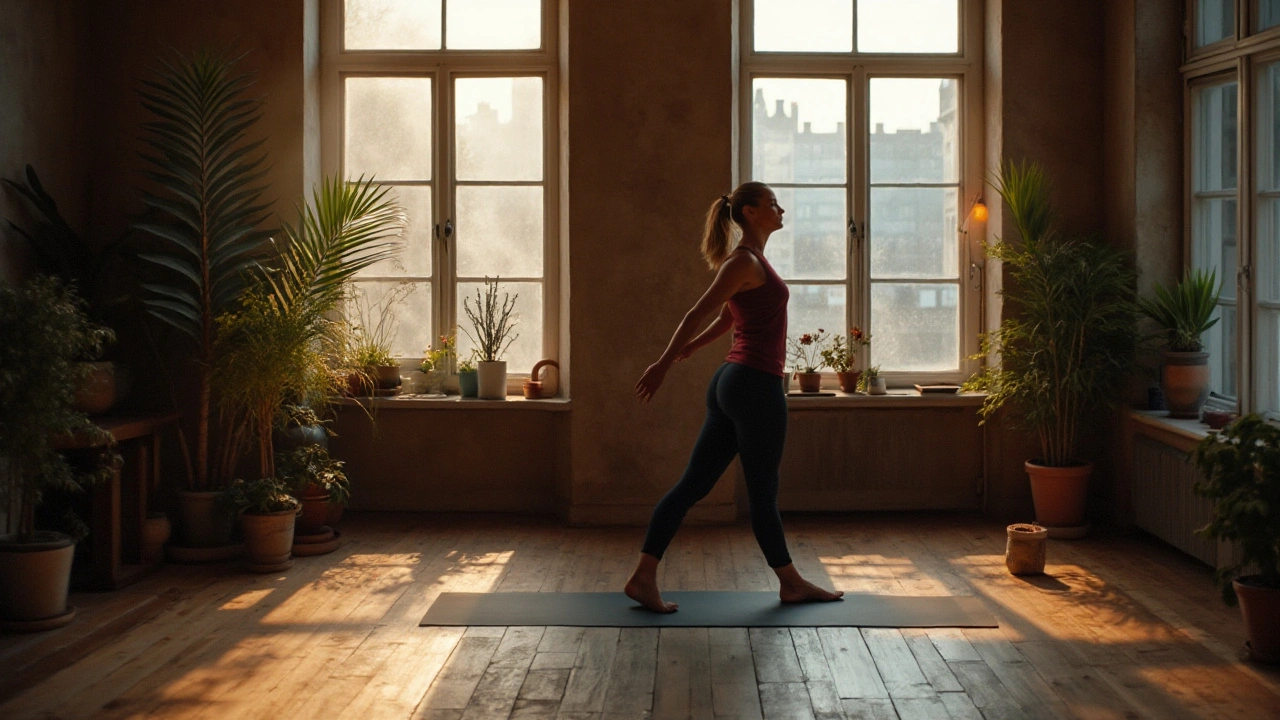Unlocking the Benefits of Feldenkrais Method Training

In the vast landscape of self-improvement techniques, the Feldenkrais Method stands out as a gentle yet potent practice aimed at enhancing human potential through movement and self-awareness. Unlike conventional exercise routines, Feldenkrais doesn’t just focus on strength or endurance; it taps into the intricate mind-body connection.
This method, developed by Moshe Feldenkrais, employs subtle movements to improve physical function and reduce pain. By paying close attention to how you move, you not only enhance your posture and coordination but also foster a healthier relationship with your body.
As people seek alternatives to invasive medical treatments, Feldenkrais offers a holistic approach to tackling physical and emotional challenges. Its focus on mindful movement makes it accessible to everyone, regardless of age or fitness level, transforming the way many perceive and engage with their own bodies.
- Understanding the Feldenkrais Method
- How Feldenkrais Differs from Other Techniques
- Physical Benefits of Feldenkrais
- Mental and Emotional Wellbeing
- Integrating Feldenkrais into Daily Life
- Getting Started with Feldenkrais
Understanding the Feldenkrais Method
At the heart of the Feldenkrais Method lies the principle that awareness through movement can lead to profound improvements in how we function. It was developed by Moshe Feldenkrais, a physicist and martial artist, in the mid-20th century. His unique background allowed him to combine insights from physics, biomechanics, and psychology into a holistic method focused on using gentle movement and self-awareness to unlock human potential. This method is not just exercise; it's a process of learning, which encourages participants to explore and become aware of subtle differences in their body movements.
One of the core aspects of Feldenkrais is its two fundamental techniques: Awareness Through Movement (ATM) and Functional Integration (FI). In ATM, practitioners often conduct sessions within a group setting, leading participants through a series of slow, mindful movements. This allows individuals to explore their own movement habits and discover more effective ways of functioning. On the other hand, FI is a personalized, hands-on experience where a practitioner guides the participant’s movements, providing tailored feedback that is based on the individual’s specific needs and abilities.
Many who practice Feldenkrais report an improved sense of balance, greater flexibility, and more comfort in their daily activities. What sets it apart from other movement practices is its focus on learning and the central belief that awareness can bring change. Much like how a child learns through play, Feldenkrais encourages playful exploration to facilitate learning, observation, and, ultimately, transformation.
Dr. Feldenkrais himself once stated, "What I am after is more flexible minds, not just more flexible bodies." It's a testament to the method’s comprehensive approach, addressing both mental and physical aspects of wellbeing. The technique empowers individuals to listen to their bodies, understand their movement patterns, and thus enables them to address discomfort and inefficiency at their root.
It's fascinating to see how the Feldenkrais Method touches on various aspects of life and health. Some practitioners have even found it beneficial in addressing back pain, cerebral palsy, and rehabilitation after strokes or injuries. Surveys suggest a growing adoption, with users ranging from older adults seeking better mobility, to professional athletes aiming for peak performance levels. Feldenkrais is adaptable, suiting various needs which proves it is more than just a 'therapy'—it's an educational tool for life.
In comparison to typical fitness routines which often emphasize repetition and exertion, Feldenkrais encourages you to move with lightness and ease. This not only makes it more accessible to individuals of all ages and fitness levels but also creates an inclusive space where self-improvement is about quality, not quantity. The beauty of Feldenkrais lies in its gentle approach, fostering a non-judgmental and curious environment, which encourages exploration rather than perfection.
For anyone interested in cultivating a deeper understanding of their body and mind, Feldenkrais offers a refreshing and insightful journey. Whether you are recovering from an injury, dealing with chronic pain, or simply curious about moving more efficiently, this method provides a valuable toolkit. The integration of mind and body highlights a shift in how we perceive movement and well-being, proving that the Feldenkrais Method is truly revolutionary.
How Feldenkrais Differs from Other Techniques
The Feldenkrais Method is distinct in its approach to movement and body awareness. Unlike traditional therapies that often emphasize repetition and effort, Feldenkrais focuses on gentle, exploratory movements. The central idea is to teach the body how to learn, rather than prescribing a set of exercises to be followed blindly. This self-guided aspect is what sets it apart, making it more of a learning process than a workout.
While conventional physical therapies might focus on strengthening specific muscles or joints, Feldenkrais encourages a holistic view of the body's movements, integrating mental and sensory awareness into physical activity. Practitioners often notice improvements in mobility and posture because the method trains them to move more efficiently and comfortably. This emphasis on quality over quantity means the benefits linger long after a session has ended.
Another key difference lies in the mindfulness inherent to the practice. Unlike yoga, which also focuses on awareness but within set poses, movement in Feldenkrais is fluid and adaptive. The idea is not to achieve a particular form but rather to explore the best movements for one's unique body. There is no corrective pressure, and practitioners are encouraged to listen to their bodies at all times, promoting a compassionate self-care attitude.
"The Feldenkrais Method is founded on the understanding that awareness of movement can effect profound changes in self-organization and well-being." - International Feldenkrais Federation
This method's non-invasive nature makes it accessible to a broad range of individuals, from professional athletes seeking to fine-tune their movements to seniors looking to maintain flexibility and reduce pain. Even those recovering from injury can benefit from the subtle exercises that do not stress the body. This accessibility levels the playing field, offering a distinct advantage over more rigorous techniques that might exclude certain groups due to physical limitations.
Consider the impact of everyday life and stress on our physical state. Our bodies naturally adopt habits and tensions over time, which can lead to pain and discomfort. By emphasizing awareness through Feldenkrais, practitioners are equipped to identify and change these habits, leading to a more balanced and comfortable lifestyle. This self-awareness replaces outdated movement patterns with new, more efficient ones, contributing significantly to long-term wellbeing.
In examining how Feldenkrais stands out, one might look at its lack of competitive culture. Here, there's no pressure to match the abilities of others, which creates a more personal and introspective journey. In many ways, the method mirrors meditation practices but with an active focus, seamlessly blending the mind's focus with the body's natural abilities. This unique integration helps form pathways to improved body image, perceptual awareness, and personal growth.

Physical Benefits of Feldenkrais
The Feldenkrais Method is truly a game-changer when it comes to enhancing body awareness and improving physical capabilities. This method, which might seem deceptively simple, is grounded in the idea that small, precise movements can lead to substantial improvements in overall physical health. Many practitioners find that their posture improves significantly after mere weeks of practice. This isn't because they're forcing their bodies into rigid positions, but because they have learned to move in a manner that's more aligned with how their bodies naturally want to function. This ease of movement leads to reduced strain and tension, sparking a cascade of benefits that include more energy in daily life.
The Science Behind the Movement
Understanding how Feldenkrais works requires a deeper look into neurology. It operates on the principle of neuroplasticity, which is the brain's ability to reorganize itself by forming new neural connections throughout life. Through mindful attention to movement, Feldenkrais encourages the brain to develop alternative ways of moving, increasing the efficiency and fluidity of motion. This method promotes better functioning joints by reducing stress and increasing the ease of movement. The outcome is often noticeable pain relief, sometimes even in chronic conditions where other treatments have failed. A 2022 study in the Journal of Bodywork and Movement Therapies showed that participants practicing Feldenkrais experienced a considerable reduction in perceived bodily pain, highlighting its potential as a therapeutic practice.
Improving Flexibility and Balance
If you've ever experienced the frustration of tight muscles or poor balance, Feldenkrais might just be the breath of fresh air you need. The practice pays meticulous attention to the subtle ways we hold tension and compensates in our bodies, gently guiding us toward releasing these habitual patterns. As these ingrained habits release their hold, flexibility often increases naturally. Many people report feeling not just more stable, but also more graceful in their movements. While other practices may focus simply on stretching, Feldenkrais offers a more organic route to achieving a supple body by actually training the nervous system. It's like updating the software rather than tweaking the hardware. Notably, this balance and flexibility help reduce the risk of falls, which is particularly beneficial for the aging population.
"What I’m after isn’t flexible bodies, but flexible brains. What I’m after is to restore each person to their human dignity." — Moshe Feldenkrais
The Feldenkrais Method's unique focus on movement awareness can be particularly effective for athletes aiming to enhance performance. By refining coordination and learning to use less effort in movement, athletes often find they can unlock new levels of performance without the added risk of injury. By reducing unnecessary muscular exertion, the body can perform with greater efficacy and endurance. Whether you're a professional athlete or someone who simply wants to enjoy the freedom of movement that comes with a supple, balanced body, Feldenkrais has something to offer. Its benefits are both wide-ranging and deeply impactful, making it a remarkable tool in the journey towards physical wellbeing.
Mental and Emotional Wellbeing
One of the most intriguing aspects of the Feldenkrais Method is its profound impact on mental and emotional wellbeing. Often, we underestimate how interconnected our minds and bodies truly are. Many people walk through life feeling disconnected from their own bodies, unaware of how this disconnect might affect their mood and thought processes. Through the practice of mindful movement, Feldenkrais helps bridge this gap, encouraging individuals to become more attuned to the sensations and emotions residing within them. This method cultivates a heightened awareness that gradually translates into greater emotional stability and mental clarity. As practitioners begin to listen to their bodies and respond to their intrinsic needs, changes in emotional patterns often coincide with behavioral shifts, offering them a fresh perspective on handling life's challenges.
The journey toward improved emotional health via Feldenkrais is profoundly personal yet universally accessible. Unlike many conventional therapies that might focus on combating symptoms directly or through verbal introspection, Feldenkrais invites practitioners into an exploratory space. This non-judgmental environment encourages them to probe their physical responses to stress and anxiety without preconceived notions or the need for immediate solutions. As individuals engage in this exploratory process, they often report a sense of calmness and reduced anxiety, outcomes that arise naturally out of re-establishing a harmonious relationship with one's own body. A study conducted by renowned psychologist Dr. Erin McCarthy observed participants who consistently practiced Feldenkrais and found significant reductions in anxiety levels compared to those using traditional physical therapies.
"Through gentle and conscious movement, Feldenkrais sessions transform how individuals perceive challenges, fostering resilience without force," Dr. McCarthy noted.
A unique feature of the Feldenkrais Method is how it promotes emotional growth without the pressure of expectations. It encourages practitioners to progress at their own pace, honouring their own experiences and thresholds. This personal freedom in learning and adapting movement helps build confidence and can do wonders in revitalizing one's self-image. Often, as practitioners embark on this journey, they find themselves developing a new spectrum of emotional resilience. This resilience does not merely serve as a buffer against stress but also as a foundation that supports creativity and spontaneity in everyday life. Body awareness enhances emotional regulation, allowing individuals to approach difficult situations with a clear mind and an open heart.
It is fascinating to note the direct impact that movement therapy, such as Feldenkrais, can have on one's mental and emotional state. During practice, it is common for latent emotions to surface, unearthing layers of tension and past experiences that have been physically and emotionally internalized. Recognizing these patterns is often the first step toward emotional healing. By learning new patterns, the body rewires its responses, replacing entrenched behaviors with balanced reactions. This not only alleviates emotional stress but also empowers individuals to confront their fears and past traumas with newfound courage, without the need for verbal confrontation.
The Feldenkrais Method, in essence, provides tools that help individuals reconnect with not just their physical bodies, but also their mental and emotional selves. As they learn to move with intention and awareness, they forge a path toward emotional freedom and inner peace. The benefits, while rooted in physical movement, extend far beyond the confines of the mat, offering transformative experiences that remain integral to life outside of practice sessions. This holistic approach to wellbeing is perhaps the Feldenkrais Method's greatest contribution, making it an invaluable practice for anyone seeking betterment across both physical and mental health domains.

Integrating Feldenkrais into Daily Life
Bringing the Feldenkrais Method into your everyday routine can transform how you experience movement, relaxation, and overall wellbeing. It may seem challenging at first to incorporate a new practice into your bustling life, but with simple steps, it becomes an inspiring journey rather than an obligation. The beauty of Feldenkrais lies in its adaptability; you can practice it almost anywhere, from the coziness of your home to the buzzing energy of your workplace.
To begin, consider setting aside just a few minutes each day to explore body awareness. Choose a quiet spot where you can practice without distractions. Start by focusing on your breath and observing how your body feels in its current state. This attention to detail—what Feldenkrais enthusiasts call 'Awareness Through Movement'—helps deepen your understanding of habitual patterns that may cause discomfort or inefficiencies in your daily activities. You might notice tensions that you weren’t aware of before—and that's a fantastic starting point for change.
Daily Movement Exploration
Integrating Feldenkrais practice into daily tasks can turn mundane activities into opportunities for growth and learning. When you’re standing in line, for example, pay attention to your posture. Are you leaning more on one leg? Try shifting your weight evenly, noticing the sensations in your feet and spine. As you move about your day, remain conscious of the body awareness that Feldenkrais fosters. When washing dishes or typing, notice the motion of your hands. Are your shoulders relaxed? Is your breathing steady? These small shifts in awareness can significantly reduce fatigue and improve efficiency.
Movement therapy benefits are amplified when practiced regularly, as consistency nurtures the mind-body connection that the Feldenkrais Method emphasizes. There's a saying by Moshe Feldenkrais himself:
"What I'm after isn’t flexible bodies, but flexible brains. What I’m after is to restore each person to their human dignity."His philosophy shifts the focus from mere physicality to a holistic engagement with our sensations, emotions, and intentions.
Group Practices and Community Learning
Another great way to incorporate Feldenkrais into your life is by joining a class or workshop. These sessions often allow for a richer learning experience due to the collective energy and shared insights from other participants. Sydney, with its diverse wellness community, hosts many such gatherings. As you practice within a group, you gain different perspectives and the chance to refine your techniques under the guidance of experienced practitioners. This communal aspect not only enhances the learning process but also makes it a social experience, further boosting motivation and enjoyment.
- Start with small, manageable sessions of just 5-10 minutes a day.
- Incorporate Feldenkrais into daily routines, like during your morning stretch or before bedtime.
- Find a local class or an online community for additional resources and support.
- Keep a journal to track your progress and reflect on how you feel before and after practice.
The success of integrating Feldenkrais into daily life lies in its gentle, non-invasive approach that invites subtle yet profound improvements over time. As you develop a deeper understanding and appreciation for your movements, what begins as a simple daily activity can evolve into a rewarding lifelong journey of personal growth and healing.
Getting Started with Feldenkrais
Embarking on the journey of the Feldenkrais Method involves a shift in how you relate to your body and movement. Initially, it might seem unusual compared to traditional fitness routines because it prioritizes awareness over exertion. To begin, it's worth understanding that Feldenkrais is not about achieving a particular level of physical prowess but rather enriching the quality of your movements. Most beginners start with a class or a private session under the guidance of a certified instructor who introduces them to the core principles. This environment is valuable because it provides the opportunity to receive personalized feedback and support tailored to your body's unique responses.
A typical Feldenkrais session, often referred to as Awareness Through Movement (ATM), usually begins with simple exercises on a mat. You might find yourself exploring basic actions like raising an arm or shifting weight from one foot to the other. These movements are executed slowly and with intent, encouraging you to pay close attention to each sensation and discovering new patterns within your own range of motion. The aim is to cultivate a state of mindfulness where the mind and body engage in a dialogue, leading to insightful discoveries about habitual movement patterns that often go unnoticed.
For those considering incorporating Feldenkrais into their routine, consistency is key. Regular practice, even as little as 20 minutes a day, can lead to tangible improvements in flexibility, posture, and relaxation. To enhance your learning, many practitioners recommend keeping a journal of your experiences. Recording these reflections can help you track changes over time and reinforce the new patterns of movement being learned. This practice not only deepens your understanding but also motivates continuous exploration and growth.
Accessing Feldenkrais resources is easier than ever, thanks to the myriad of online platforms. Numerous videos and audio lessons are readily available, providing a practical way to practice at home. In addition, many respected practitioners have published books that delve into the theory and exercises of Feldenkrais, offering deeper insights into its philosophy and application. While self-practice can be incredibly beneficial, returning to an instructor from time to time can help correct any unconscious habits that might develop during solo practice.
"The Feldenkrais Method will empower you to think, feel, and move with greater freedom and resilience." - Dr. Norman Doidge
When starting with Feldenkrais, feel encouraged by the fact that you don't need any specialized equipment. Comfortable clothing that allows unrestricted movement is all that is required. The simplicity of the setup means you can practice almost anywhere, making it an accessible form of exercise. As you develop familiarity with the method, you'll likely find that its benefits spill over into everyday life, influencing how you sit, stand, and move through each day with greater ease.





